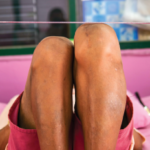Rheumatology quality in general is fine, but manpower shortages and competition from orthopedic doctors lead to lack of specialty knowledge, hence rendering patient care inferior. My lupus patient of six months is a 38-year-old African American female who has a concurrent diagnosis of Sweet’s syndrome proven by skin biopsy with symptoms of acute febrile neutrophilic dermatosis. Her lupus and/or connective tissue disease has been based on polyarthritis, positive antinuclear antibody test, SSA, lack of dry eyes, lack of dry mouth, and otherwise negative rheumatologic review of systems. She has generally been well controlled on hydroxychloroquine and 5 mg of prednisone. This includes her rash of Sweet’s syndrome and her arthritis from connective tissue disease.
I was recently called to the hospital to see the lady. I was told she was admitted with a stroke. I was asked to see her three days after admission. By the time I saw her, she had seen an emergency room physician, psychiatrist, physiatrist, neurologist, and orthopedic surgeon. She had had extensive testing from the above-named physicians including a “thorough orthopedic evaluation and a thorough physiatry evaluation.” She had been scheduled and had not yet started physical therapy for right arm and leg weakness, and she had seen a neurologist who performed an MRA of the brain with contrast that was normal.
Upon entering the room, I noticed that the patient was walking with her IV connection to the bathroom on her own. She did not appear weak. I asked her to get back on the bed and performed a history and physical. It was quickly obvious that she had right-sided weakness of the arm and leg that was related to pain. It was also immediately obvious that she had a normal neurologic exam—in fact, the neurologist concurred, so he concluded this may have been a transient ischemic attack or a reversible ischemic neurologic deficit. More specific on my exam, the patient had a large right knee effusion and periarticular shoulder pain. The periarticular shoulder pain was the reason she could not move her arm. The knee effusion was the reason she had a hard time moving her leg. After aspirating 90.0 cc of mildly inflammatory fluid from her right knee and injecting the knee with 80 mg of DepoMedrol, the so-called stroke from her right leg disappeared. After injecting the short and long head of her biceps tendon sheath, which were both tender on her exam, as well as the rotator cuff tendon sheath, which appeared to be involved in her problem, she immediately had full unrestricted range of motion of her right arm. She was subsequently discharged the following morning. Her discharge summary indicated that she had central nervous system lupus.

